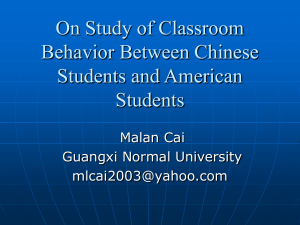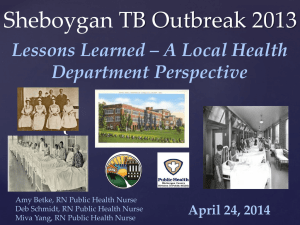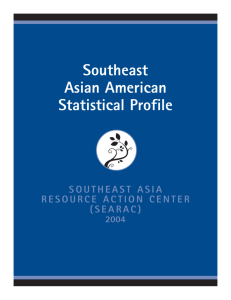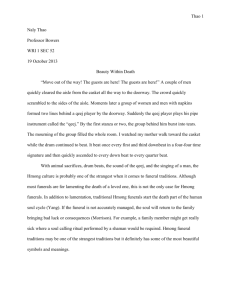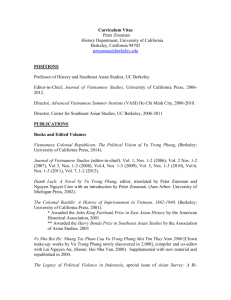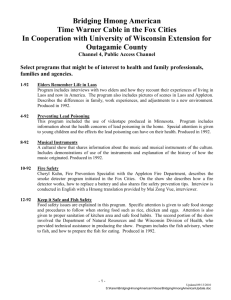CSUF Teaching Presentation -12-05-06
advertisement
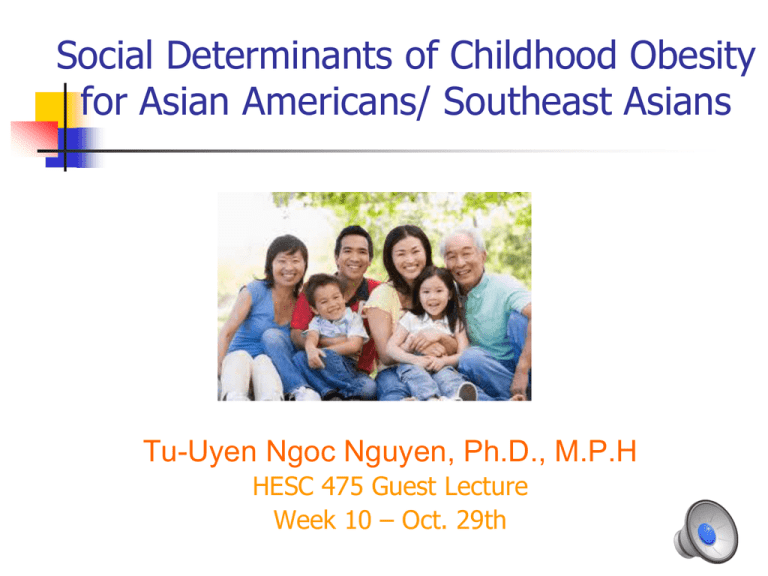
Social Determinants of Childhood Obesity for Asian Americans/ Southeast Asians Tu-Uyen Ngoc Nguyen, Ph.D., M.P.H HESC 475 Guest Lecture Week 10 – Oct. 29th Learning Objectives 1) Outline API diversity - fastest growth rate, majority are immigrants. 2) Introduce "model minority" concept - effects on public perceptions of API health 3) Outline traditional Southeast Asian health practices – * yin/yang concept, coining, cupping, use of medicinal herbs 4) Outline differences between Southeast Asian communities – *culture, immigrant vs. refugee experiences, geography, SES, health 5) Introduce Social-Ecological Model & use in developing effective obesity prevention programs for Southeast Asian communities. 6) Discuss physical activity/ nutrition programs/ interventions in SEA communities AAPI Health Disparities 1) Rapid population growth 2) Model minority myth 3) Inadequate data on health of AAPIs (paucity of data - inadequate sample size), misclassification of data, lack of disaggregated ethnic specific data 4) Lack of resources API Model Minority Images From 1992 to 2001, Overweight Increased Most Sharply for California API Low-Income Children, Increasing 127% from 5.9% to 13.4% 140% Percent change of overweight, low-income CA children* 127% 120% 100% 80% 60% 40% 35% 43% 50% 60% AN/AI Latino Black White 20% Asian/PI 0% AN/AI Latino Black White Asian/PI Overweight = BMI > 95th percentile. Overweight is comparable to obesity in adults. * Children 5 - >20 years old Source: California Dept. of Health Services, Children’s Medical Services Branch, California Pediatric Nutrition Surveillance System Southeast Asia: Cambodia Laos Thailand Vietnam Who are Southeast Asian Refugees? Cambodian (Khmer) Laotians (over 60 different ethnic groups) Hmong Khmu Mien Vietnamese (over 50 different ethnic groups) Others displaced and forced to flee from their homelands because of the Vietnam/ American War Cultural Concepts of Health, Disease, Illness YIN/YANG Concept ~ Two opposing forces must be in balance to maintain good health. ~ There are no “good” or “bad” foods – just foods that have hot and cold properties and are in eaten in balance, depending on state of health. “COINING” ~ A traditional Southeast Asian folk treatment in which a coin is dipped in a mentholated liquid and rubbed vigorously over sections of skin on the body. CUPPING/ MOXIBUSTION ~ Heated glass vials are placed on the skin, creating a suction when they cool. MEDICINAL HERBS THE HEALTH STATUS OF AAPIs: Obesity by Acculturation Impact on Children is Hardest • Among immigrant API: number of years in the US = weight. • Obesity x2 from first to second generation AA adolescents. •Asian children born outside the U.S. have less obesity than those born in US of immigrant parents. •1996 Medical Expenditure Survey shows: Latino and API adolescents more overweight. •Obese children who grow into obese adults live 10 – 20 fewer years Haas JS, American Journal of Public Health, 2003 Popkin BM, American Society for Nutritional Sciences, 1997 Obesity is increasing problem in AAPI Communities Social Ecological Model/ Perspective The Social Ecological perspective is a multilevel, dynamic & inter-disciplinary approach to understanding how health issues are influenced by 5 interacting levels: • Intrapersonal or Individual factors • Interpersonal or Family factors • Organizational or Institutional factors • Community factors • Public Policy factors ~ McLeroy et al., 1988. Applying the Social Ecological Perspective to Obesity Prevention Example: Increasing Physical Activity Intrapersonal/Individual Factors: Knowledge, beliefs, attitudes, practices on nutrition & physical activity Interpersonal Factors: Family/ Provider support for physical activity; Social networks enabling physical activity Institutional/Organizational Factors: Availability - Interpretation & culturally competent health services provided by places of care (e.g. clinics, hospitals, community-based organizations –CBOs); Accountability - Follow-up & treatment; Accessibility – Work hours, Transportation Community Factors: Acceptability - Community norms for physical activity; Feelings of discrimination/ racism Public Policy Factors: Affordability of services – Insurance coverage policies; free/low cost programs UCLA Case Study Research on Five a Day Campaign in 3 Asian Communities Explored knowledge, attitudes, opinions and reported behavior health and healthy lifestyles dietary practices fruit and vegetable consumption physical activity Among 3 low-income Asian-American ethnic groups in CA: Chinese, Hmong, Vietnamese Reported findings and recommendations to DHS/CPNS for formal presentation at the 2004 Sacramento AANCART Academy ~Harrison et. al. Seizing the Moment (2005). Cancer Supplement 104(12):2962-2968 Community Partners UC Extension, Berkeley Hmong Women’s Heritage Association Kai Ming Head Start Stone Soup Chinatown Service Center Vietnamese American Cancer Foundation Sample Selection Criteria Ethnicity: Chinese, Hmong, and Vietnamese Poverty: Below 185% federal poverty level Sites: Los Angeles, San Francisco, Fresno, Sacramento, Elk Grove, Little Saigon, San Jose Participants: 116 Adult FG Participants, age 25-80 105 Youth FG Participants, age 11-14 15 Key Informants, age 25-62 236 Total Common Health Beliefs of Chinese, Hmong and Vietnamese Importance of F&V consumption and PA for general health Health includes concept of harmonious family and balance Healthy foods = fresh foods: pesticidefree, recently picked/slaughtered, hormone-free, non-frozen, not canned Concept of “warm” and “cool” foods Home-cooked meals healthier than eating out Two overall goals for campaign from CAANPAC findings: 1) Maintenance of cultural integrity and pride 2) Necessity of cultural tailoring Ways to Encourage/Maintain F & V Consumption: Commonalities Highlight importance of eating F&V daily Creative cooking to include F&V in every meal Educate parents and children about proper nutrition and benefits of F&V Have family dinners & create positive eating environment Parents serve as role models Purchase/serve more F&V Teach children at an early age to eat F&V Ways to Encourage/ Maintain- Individual Level of Health Physical Activity: All groups agreed: Reinforce tradition of family activities with children Provide low-cost or free supervised physical activities in the community Improve access to parks and playgrounds Common Strategies and Suggestions-Group Level Educational Materials/Workshops & Classes In-language materials Visual: pamphlets, stickers, health videos, posters, book covers, key chains Audio: Radio, incorporate music/jingle More pictures, less words Educational classes Churches/temples Community-based agencies Doctor’s offices/clinics Health fairs Asian Supermarkets Schools Locations for Education/Outreach Strategies and SuggestionsCommunity Level Media COMMON: In-language TV and radio Parents: commercials/PSAs between 6pm-8pm Use networks/programs children enjoy watching (e.g. cartoons) Shock campaigns (e.g. Truth.com) Using animation, celebrities, and/or athletes to market the message (e.g. Got Milk?) Billboards and signs also mentioned CULTURE SPECIFIC: Chinese: In language newspapers Hmong: In language health videos Vietnamese: In language TV and radio Strategies and Suggestions Health Information Messengers COMMON: Parents (mothers) Teachers Community health outreach worker/social workers Community/religious leaders Doctors, Nurses, Nutritionists, Health educators CULTURE SPECIFIC: Chinese: Celebrities and Athletes Hmong: Counselors, Friends/Peers Chinese & Hmong: PTA Maintenance of cultural integrity and pride Need Knowledge of benefits of traditional cultural activities, foods and family practices to pass on to their children Need knowledge of healthy mainstream American foods, sports and family expectations Lack of time default of convenience of American style meals and foods Children preferred (enjoyed) traditional foods and family time Blending of traditional and American style foods – congee and hot dogs, “Shalom Shanghai” What can we do to improve our individual and community health? Community Advocacy Healthy Diet Exercise Conclusions With greater numbers of years in the US, traditional diets will inevitably include more Western foods. Helping our children become healthy adults means eating wisely and maintaining physically active lives.







